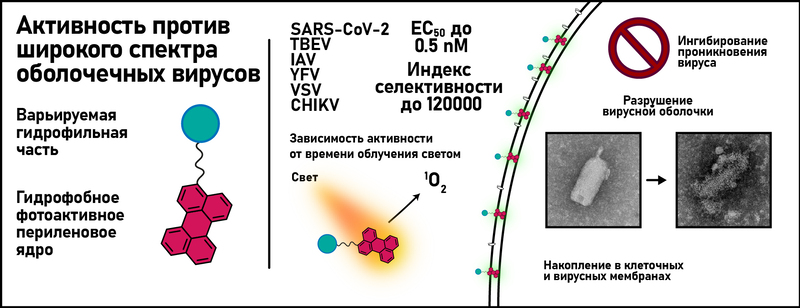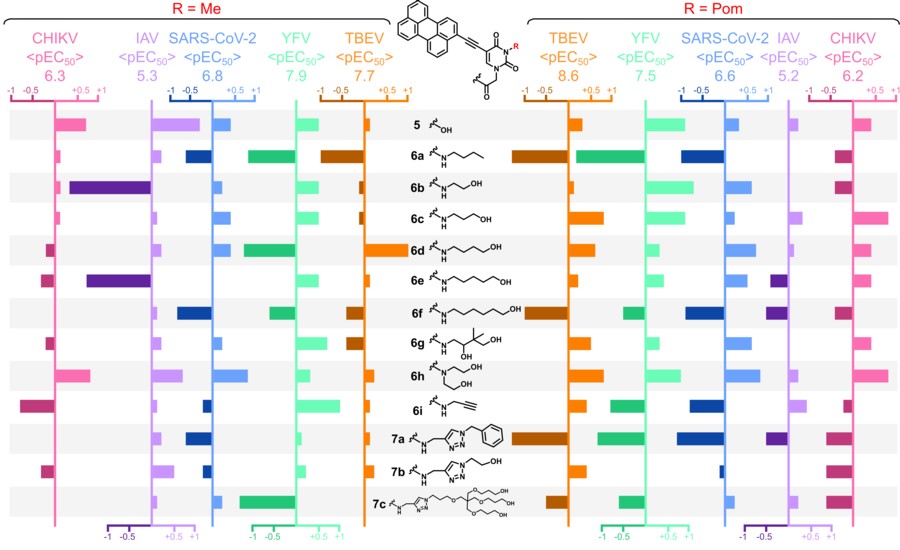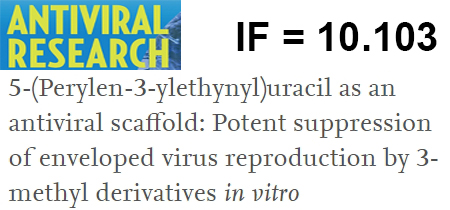Press-room / news / Science news /
5-(Perylen-3-ylethynyl)uracil as an antiviral scaffold: Potent suppression of enveloped virus reproduction by 3-methyl derivatives in vitro
A group of scientists from the Laboratory of Molecular Design and Synthesis, the Protein Growth and Differentiation Factor Expression Group of the Institute of Bioorganic Chemistry, Russian Academy of Sciences, the Institute of Poliomyelitis and other institutes synthesized a series of compounds based on 5-(perylene-3-ylethynyl)uracil and studied their antiviral properties and mechanism of action. Previous studies of this class of compounds have suggested controversial types of mechanisms of action. Nonetheless providing comparable high activity. The present study showed that, upon irradiation with light, amphiphilic compounds accumulated in cell and viral membranes inhibit the entry of enveloped viruses into the cell.

Figure 1. Graphical abstract which represents main results of study
Amphipathic nucleoside and non-nucleoside derivatives of pentacyclic aromatic hydrocarbon perylene are known as potent non-cytotoxic broad-spectrum antivirals. Here scientists report 3-methyl-5-(perylen-3- ylethynyl)-uracil-1-acetic acid and its amides, a new series of compounds based on a 5-(perylen-3- ylethynyl)-uracil scaffold. The compounds demonstrate pronounced in vitro activity against arthropod- borne viruses, namely tick-borne encephalitis virus (TBEV) and yellow fever virus (YFV), in plaque reduction assays with EC values up to 1.9 and 1.3 nM, respectively, and Chikungunya virus (CHIKV) in cytopathic effect inhibition test with EC values up to 3.2 μM (Figure 2). The compounds were active against respiratory viruses as well: inhibited severe acute respiratory syndrome-related coronavirus 2 (SARS-CoV-2) in cytopathic effect inhibition test and influenza A virus (IAV) in virus titer reduction experiments - EC values up to 51 nM and 2.2 μM, respectively (Figure 2).

Figure 2. Activity comparison diagram. Each vertical axis corresponds to average antiviral activity in the series of N1-substituents, the average value (pEC50 = -log10EC50) is shown above the axis. Each bar represents the difference of activity from the average value depending on the N1-substituent. Each row corresponds to a single N1-substituent, the left side shows data for the N3-Me series, the right one for the N3-Pom series. Negative deviations are shown with darkened bars.
The activity is determined by the presence of a hydrophobic perylene core (Figure 1), all of the synthesized compounds exhibited comparable singlet oxygen 1O2 generation rates. Nonetheless, the activity can vary by orders of magnitude depending on the hydrophilic part of the molecule, suggesting a complex mode of action (Figure 2). Time-of-addition experiment and fluorescent imaging technique indicate that the compounds inhibit viral fusion in dose-dependent manner. Localization of the compound in lipid bilayers and visible damage to viral envelope suggest membrane as primary target. Dramatic reduction of antiviral activity with limited access of light or under treatment with antioxidants further cements the idea of photoinduced ROS-mediated viral envelope damage to be the mode of antiviral action (Figure 1).
The results are published in the Antiviral Research.
january 23, 2023


